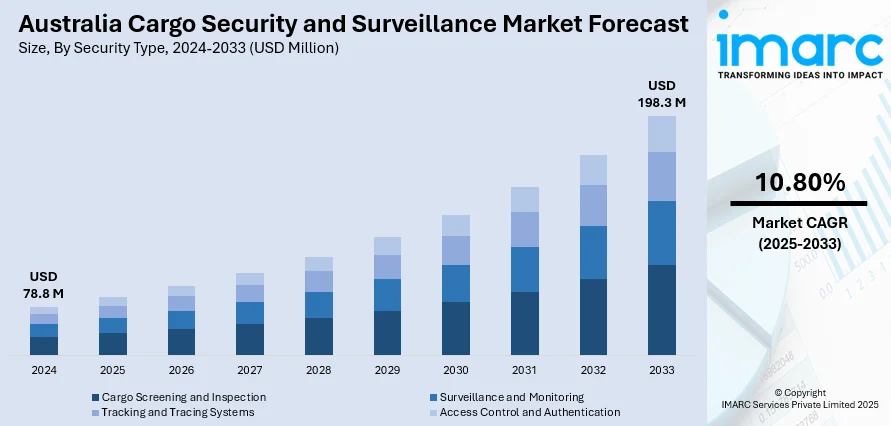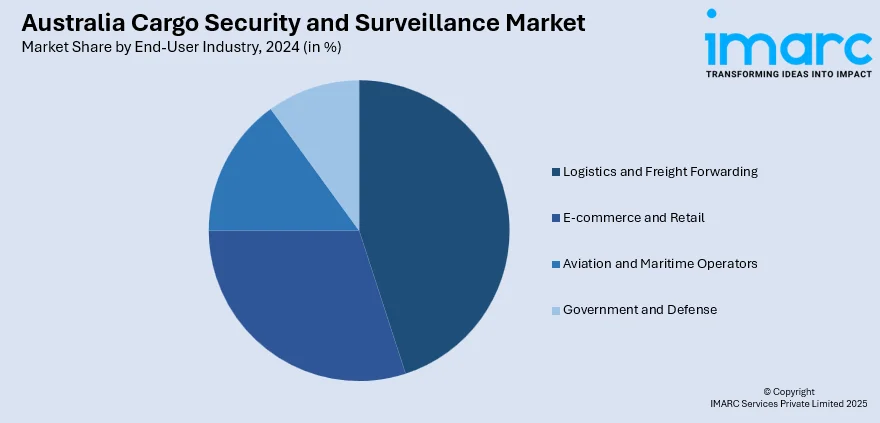
Australia Cargo Security and Surveillance Market Size, Share, Trends and Forecast by Security Type, Mode of Transport, Technology, End-User Industry, and Region, 2025-2033
Australia Cargo Security and Surveillance Market Overview:
The Australia cargo security and surveillance market size reached USD 78.8 Million in 2024. Looking forward, IMARC Group expects the market to reach USD 198.3 Million by 2033, exhibiting a growth rate (CAGR) of 10.80% during 2025-2033. The market is moving forward on cargo security with artificial intelligence (AI) driven surveillance, intelligent tracking systems, such as radio-frequency identification (RFID) and global positioning system (GPS), and biometric access controls. These technologies upgrade real-time surveillance, increase threat detection, and advance identification at major transport points. As modernized logistics networks are developed, the fusion of intelligent and secure systems means more secure cargo protection, visibility, and operational effectiveness, propelling Australia cargo security and surveillance share.
|
Report Attribute
|
Key Statistics
|
|---|---|
|
Base Year
|
2024
|
|
Forecast Years
|
2025-2033
|
|
Historical Years
|
2019-2024
|
|
Market Size in 2024
|
USD 78.8 Million |
|
Market Forecast in 2033
|
USD 198.3 Million |
| Market Growth Rate 2025-2033 | 10.80% |
Australia Cargo Security and Surveillance Market Trends:
Integration of AI-Powered Surveillance Systems
Australia is experiencing a revolutionary change in cargo security by integrating artificial intelligence (AI)-driven surveillance systems. These technologies are highly being implemented at transport terminals, logistics chains, and warehouses to track cargo movement in real-time. AI-driven video analytics can identify irregular patterns, automate threat detection, and lower response times, thus preventing security violations. Improved object recognition, behavior forecasting, and anomaly detection also enhance classical surveillance techniques to provide increased cargo safety and improved efficiency. Machine learning application also allows systems to enhance themselves over time by learning from input data and adapting evolving risk situations. With the transport and logistics industry continuing to evolve, AI solutions are becoming crucial in the protection of high-value cargo and maintaining regulatory compliance. Australia's cargo security and surveillance development is being spurred by this strategic deployment of smart monitoring technologies. As per the news, in August 2024, Security's Start-up Zone in ICC Sydney promoted innovations like cloud-based risk automation by Cognetiq, surveillance solutions by 4tfi, and AI biometric vehicle protection by Sentinel IoT, propelling Australia's cargo and asset security toward smarter, more automated technologies.

To get more information on this market, Request Sample
Expansion of Smart Tracking Using RFID and GPS Technologies
One of the major trends that are shaping Australia's cargo security environment is the widespread deployment of smart tracking technologies, particularly radio-frequency identification (RFID) and global positioning systems (GPS). These technologies give end-to-end visibility of shipments through supply chains, which allows stakeholders to track location, condition, and transit time with accuracy. According to the sources, in October 2024, Australia's Department of Home Affairs reinstated tighter air cargo security protocols that mandate incoming consignments from 55 territories to comply with Established Business Relationship standards, bolstering cargo security on passenger flights in the face of international threats. Moreover, RFID tags attached to shipment units enable unproblematic inventory tracking, while GPS functionality gives real-time status of transport routes and delivery timetables. Combined, they facilitate detection of discrepancies like route deviation or unauthorized entry, allowing for quicker corrective measures. The information produced by these systems also facilitates analytics and predictive maintenance, streamlining logistics operations while enhancing security structures. Such real-time information exchange aids increased transparency, confidence, and efficiency in cargo movement. Amplified demand for traceability, regulatory compliance, and customer satisfaction is driving digital logistics expansion. These drivers underpin Australia cargo security and surveillance market growth in both city and remote transport corridors.
Onset of Biometric and Access Control Systems in Cargo Complexes
Australia is intensely making use of biometric verification and sophisticated access control systems in order to secure cargo complexes and restricted areas. Biometric technologies like fingerprint scanning, facial recognition, and iris detection are substituting manual checks in order to offer greater identity assurance. These systems are most useful in airports, seaports, and big distribution centers where several staff members handle sensitive cargo. Biometric information reduces the risk of unauthorized access and insider threats since only authenticated people will be able to enter sensitive areas. Integrated access logs also ensure detailed audit trails for regulatory and internal auditing. Additionally, such systems can be interfaced with surveillance and alarm systems to initiate automated actions during a breach. This increasing dependence on access management and biometric is an important leap in developing physical security infrastructure. Consequently, Australia's cargo security and surveillance development is being driven by the installment of high-precision control measures for identity.
Australia Cargo Security and Surveillance Market Segmentation:
IMARC Group provides an analysis of the key trends in each segment of the market, along with forecasts at the country and regional levels for 2025-2033. Our report has categorized the market based on security type, mode of transport, technology, and end-user industry.
Security Type Insights:
- Cargo Screening and Inspection
- Surveillance and Monitoring
- Tracking and Tracing Systems
- Access Control and Authentication
The report has provided a detailed breakup and analysis of the market based on the security type. This includes cargo screening and inspection, surveillance and monitoring, tracking and tracing systems, and access control and authentication.
Mode Of Transport Insights:
- Air Cargo Security
- Maritime Cargo Security
- Rail Cargo Security
- Road Cargo Security
A detailed breakup and analysis of the market based on the mode of transport have also been provided in the report. This includes air cargo security, maritime cargo security, rail cargo security, and road cargo security.
Technology Insights:
- X-ray Scanners
- Explosive Detection Systems (EDS)
- Video Surveillance Systems
- RFID & GPS-based Tracking
The report has provided a detailed breakup and analysis of the market based on the technology. This includes X-ray scanners, explosive detection systems (EDS), video surveillance systems, RFID & GPS-based tracking.
End-User Industry Insights:

- Logistics and Freight Forwarding
- E-commerce and Retail
- Aviation and Maritime Operators
- Government and Defense
A detailed breakup and analysis of the market based on the end-user industry have also been provided in the report. This includes logistics and freight forwarding, e-commerce and retail, aviation and maritime operators, and government and defense.
Regional Insights:
- Australia Capital Territory & New South Wales
- Victoria & Tasmania
- Queensland
- Northern Territory & Southern Australia
- Western Australia
The report has also provided a comprehensive analysis of all the major regional markets, which include Australia Capital Territory & New South Wales, Victoria & Tasmania, Queensland, Northern Territory & Southern Australia, and Western Australia.
Competitive Landscape:
The market research report has also provided a comprehensive analysis of the competitive landscape. Competitive analysis such as market structure, key player positioning, top winning strategies, competitive dashboard, and company evaluation quadrant has been covered in the report. Also, detailed profiles of all major companies have been provided.
Australia Cargo Security and Surveillance Market News:
- In April 2024, Shield AI’s acquisition of Australia-based Sentient Vision Systems strengthens Australia’s cargo security and surveillance capabilities. By integrating AI-powered real-time situational awareness with autonomous drone technology, this partnership enhances monitoring of vast maritime and land cargo zones, improving detection of threats and safeguarding critical supply chains.
Australia Cargo Security and Surveillance Market Report Coverage:
| Report Features | Details |
|---|---|
| Base Year of the Analysis | 2024 |
| Historical Period | 2019-2024 |
| Forecast Period | 2025-2033 |
| Units | Million USD |
| Scope of the Report |
Exploration of Historical Trends and Market Outlook, Industry Catalysts and Challenges, Segment-Wise Historical and Future Market Assessment:
|
| Security Types Covered | Cargo Screening and Inspection, Surveillance and Monitoring, Tracking and Tracing Systems, Access Control and Authentication |
| Mode of Transports Covered | Air Cargo Security, Maritime Cargo Security, Rail Cargo Security, Road Cargo Security |
| Technologies Covered | X-ray Scanners, Explosive Detection Systems (EDS), Video Surveillance Systems, RFID & GPS-based Tracking |
| End-User Industries Covered | Logistics and Freight Forwarding, E-commerce and Retail, Aviation and Maritime Operators, Government and Defense |
| Regions Covered | Australia Capital Territory & New South Wales, Victoria & Tasmania, Queensland, Northern Territory & Southern Australia, Western Australia |
| Customization Scope | 10% Free Customization |
| Post-Sale Analyst Support | 10-12 Weeks |
| Delivery Format | PDF and Excel through Email (We can also provide the editable version of the report in PPT/Word format on special request) |
Key Questions Answered in This Report:
- How has the Australia cargo security and surveillance market performed so far and how will it perform in the coming years?
- What is the breakup of the Australia cargo security and surveillance market on the basis of security type?
- What is the breakup of the Australia cargo security and surveillance market on the basis of mode of transport?
- What is the breakup of the Australia cargo security and surveillance market on the basis of technology?
- What is the breakup of the Australia cargo security and surveillance market on the basis of end-user industry?
- What is the breakup of the Australia cargo security and surveillance market on the basis of region?
- What are the various stages in the value chain of the Australia cargo security and surveillance market?
- What are the key driving factors and challenges in the Australia cargo security and surveillance?
- What is the structure of the Australia cargo security and surveillance market and who are the key players?
- What is the degree of competition in the Australia cargo security and surveillance market?
Key Benefits for Stakeholders:
- IMARC’s industry report offers a comprehensive quantitative analysis of various market segments, historical and current market trends, market forecasts, and dynamics of the Australia cargo security and surveillance market from 2019-2033.
- The research report provides the latest information on the market drivers, challenges, and opportunities in the Australia cargo security and surveillance market.
- Porter's five forces analysis assist stakeholders in assessing the impact of new entrants, competitive rivalry, supplier power, buyer power, and the threat of substitution. It helps stakeholders to analyze the level of competition within the Australia cargo security and surveillance industry and its attractiveness.
- Competitive landscape allows stakeholders to understand their competitive environment and provides an insight into the current positions of key players in the market.
Need more help?
- Speak to our experienced analysts for insights on the current market scenarios.
- Include additional segments and countries to customize the report as per your requirement.
- Gain an unparalleled competitive advantage in your domain by understanding how to utilize the report and positively impacting your operations and revenue.
- For further assistance, please connect with our analysts.
 Request Customization
Request Customization
 Speak to an Analyst
Speak to an Analyst
 Request Brochure
Request Brochure
 Inquire Before Buying
Inquire Before Buying




.webp)




.webp)












